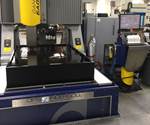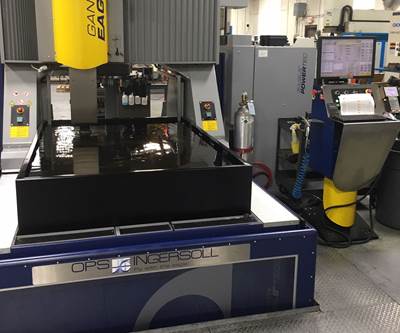Single-Brand EDM Arsenal Helps Moldmaker Speed Services for Diverse Clientele
Microtech Precision sticks with Mitsubishi EDM (and milling) technology to optimize machining capabilities for molds, dies and more.
Watch this demo of an MV Series wire EDM machine from MC Machinery Systems as it quickly and easily threads itself. The secret is in the annealing. This auto thread feature is so fast it is shown three times! Video courtesy of MC Machinery Systems Inc.
Microtech Precision Inc. (McMinnville, Oregon) uses all Mitsubishi EDM and milling machine tools. This is because John Ashton, founder and president, who has an extensive background in mold and die making, worked on other brands of EDM and milling machines before launching his own business and decided Mitsubishi was his brand of choice. “In my experience, the Mitsubishi control is the easiest to teach someone to use. I have trained several operators on the MV-Series wire EDM controller and every single one of them was able to set up and run the EDMs on their own within a few days.”
Microtech Precision Inc. uses ONE SOURCE for its EDM and milling machines
Microtech Precision, Inc. has steadily expanded since its founding in 2006, growing from a one-man job shop to a full-service tool and mold shop with six employees who design and build molds, dies, fixtures, gauges, and inspection tools. The company serves the medical, orthodontic, automotive, and aerospace industries, providing tight-tolerance EDM and milling work. It also builds fine blanking dies for Portland-based knife companies.
The first machine Ashton purchased for Microtech was a Mitsubishi FA10S wire EDM, supplied by MC Machinery Systems Inc. (Elk Grove Village, Illinois). “Starting off as a job shop, we had to be able to go from programming to having parts running fairly quickly so we could deliver them within a day or two, and sometimes same day,” he says. “The Mitsubishi control is much simpler and more straightforward to program compared to other EDMs I have worked on. In order to create one complete toolpath on the other machines, I had to write three different programs so that the post processors could relay the right code. We are writing code continuously, all day long, so it was very time consuming. With the Mitsubishi control and using Esprit software to program it, the toolpath is contained in one program, and in two steps the machine is running.” In other words, the operator writes the program and sends it to the machine. That is one step. He then picks up the part and starts the program, and that's the second step.
Compared to other software he has used, Ashton says Esprit CAM software is the best for programming Mitsubishi EDMs. This is because Esprit builds its post processors so that they are compatible with the Mitsubishi machines, hence the user is getting the right code for the machine from the start, with no extra steps required to translate the program.
Auto Threading Feature Enables 24-Hour Unattended Operation
Microtech Precision has a lean team but broad capabilities. Ashton points out, “We don't have a lot of staff here, but we sure turn a lot of work out.” An example, he says, is quick turnarounds on prototypes, where they have been able to complete that work in 24 hours. “Sometimes we will do a complete mold build in a week, depending on the complexity of it,” he says.
What’s the secret? “For one, we have so many Mitsubishi machines that we can be more flexible with our job scheduling and take on filler work,” Ashton says. “But more than that, their wire threading technology is just far superior to all the other manufacturers that I have encountered.”
Some examples include that it can thread through interrupted start holes; it can thread submerged or unsubmerged. It anneals the wire up so far that if the wire breaks during machining it can re-thread through its own wire curve, where the wire broke. For example, if you have a 0.010-inch EDM wire. It's annealed down about 0.001-inch smaller so it will fit through that gap in the workpiece, and then it pushes it back through and re-threads itself, he says.
Ashton adds that the re-threading time is also very fast. “I remember the old SX10 that I ran years ago took about a minute to thread the wire, but the newer MV Series machines take about 10 or 12 seconds,” he says.
The annealing of the wire is the primary feature that makes such high-speed threading possible. Prior to the wire going through the guides it gets annealed automatically. When we anneal the wire, we are actually applying a small amount of back tension to keep the wire tight and we put an electrical charge through that section of wire to remove any curl it has from being wound on the spool.
The previous generation and current Mitsubishi auto threaders use current to cut the wire to produce a nice tip on the end of the wire, but those that do not also anneal may experience curl at the end of the wire, which requires the operator to slow the feed cycle down to improve the threading operation and reliability. The length at which the wire is annealed is dependent on the EDM model size to accommodate Z-axis heights (currently, the annealing ranges from 14 inches to 27 inches).
The automatic annealing not only makes high-speed threading possible, but it also enables re-threading directly at the wire break point so there is no need to return to the start point, even when the part geometry requires very small start holes (0.020 inch or less). It is in these applications where the annealing process has dramatically improved the reliability of the re-threading process.
To illustrate the significance of the fast threading feature, Ashton relates that Microtech recently cut a part that had 200, 0.010-inch diameter holes that needed to be threaded. “We used a 0.004-inch wire, ran the program unattended overnight and in the morning, it was done. The machine threaded, repeatedly, through every hole, and if the wire did break it recovered on its own.”
Automation-Ready Sinker and Larger Wire EDM Expand Capacity
Microtech invested in its first sinker EDM, a Mitsubishi EAS-Series EA12V Advance, in 2006. Ashton says it is perfect for moldmaking and for machining small forming dies because it has a 20-position tool changer and a C-axis, enabling more complex cutting as well as unattended machining. It can also tap holes as small as 2-56 (0.084 inch) in hardened materials. “It's a fast machine with high accuracy and has a three-sided drop tank so it's easy to access the working area and see what you are doing,” he says, adding that the drop-tank feature also lends itself well to future automation. “For example, the tank can be programmed to lower so a robot can change out parts and then the tank will raise itself back up to continue the job.”
The company then added a Mitsubishi MVR 2400-R Advance Wire EDM. “That machine has larger travels of 23.6 x 15.7 x 12.2 versus the FA10’s travels of 13.8” x 9.8” x 8.7”, so we could put significantly larger parts through our shop,” Ashton explains. “Before, we were limited to smaller molds and that machine opened our capabilities up to the point where we started doing more work for other mold shops because we had larger machining capacity.”
Today the company has 10 Mitsubishi machines, including two CNC milling machines and an EDM drill, and can complete every process for a job in house. “When we used to send out parts and electrodes for machining it would add a minimum of two to three weeks to my lead times but now we can take that time right off the top because we're doing it ourselves in our own shop,” he says.
Related Content
Revisiting Some Hot Runner Fundamentals
What exactly does a hot runner do? If you’ve been in the injection molding industry for any length of time, you might think the answer is obvious, but it is not.
Read MoreHow to Eliminate Chatter
Here are techniques commonly used to combat chatter and guidelines to establish a foundation for optimizing the moldmaking process.
Read MoreMaintaining a Wire EDM Machine
To achieve the ultimate capability and level of productivity from your wire EDM on a consistent, repeatable and reliable basis, regular maintenance is a required task.
Read MoreRead Next
Advanced EDM Features Increase Efficiency and Change Perceptions
Unique features that drive optimum speed and accuracy in the EDM process helped change Viking Tool’s views on, and use of, EDM technologies.
Read MoreAre You a Moldmaker Considering 3D Printing? Consider the 3D Printing Workshop at NPE2024
Presentations will cover 3D printing for mold tooling, material innovation, product development, bridge production and full-scale, high-volume additive manufacturing.
Read MoreReasons to Use Fiber Lasers for Mold Cleaning
Fiber lasers offer a simplicity, speed, control and portability, minimizing mold cleaning risks.
Read More





















